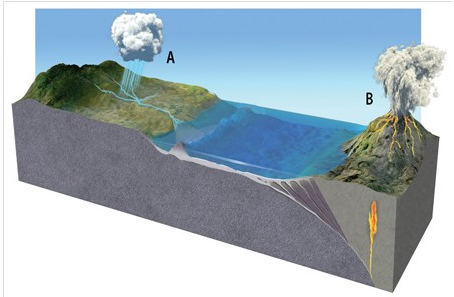In the diagram below, the importance of the falling precipitation at "A" for the global carbon cycle is that

A) the falling rain makes carbon in the atmosphere more inert, giving it much greater potential to act as a greenhouse gas and warm the Earth.
B) the falling rain brings CaCO3 which was trapped in the atmosphere to the surface, cooling the Earth.
C) the falling rain lubricates the Earth's surface, making crustal deformation more likely, which would bring carbon stored in the lithosphere back up to the atmosphere, warming the Earth.
D) CO2 combines with water to form H2CO3, removing carbon from the atmosphere and cooling the Earth.
D) CO2 combines with water to form H2CO3, removing carbon from the atmosphere and cooling the Earth.
You might also like to view...
A process for extracting natural gas that is causing a growing environmental problem involves hydraulic fracturing of rocks and is called
a. deep well mining b. strip mining c. offshore drilling d. deep water drilling e. fracking
Which properties of a lava lamp are important to remember when modeling convection?
a) The lava lamp contains three liquids with similar densities that do not mix and that expand at similar rates when heated. b) The lava lamp contains two liquids with different densities that do not mix and that expand at different rates when heated. c) The lava lamp contains two liquids with similar densities that do not mix and that expand at similar rates when heated. d) The lava lamp contains three liquids with different densities that do not mix and that expand at different rates when heated.
To keep an object cool while exposed to direct sunlight,
a. put it inside a brown paper bag. b. wrap it in black paper. c. wrap it in plastic wrap. d. wrap it in aluminum foil with the shiny side facing outward e. put it inside a clear container.
Salt domes account for most of the petroleum reserves in the U.S. midcontinent.
Answer the following statement true (T) or false (F)